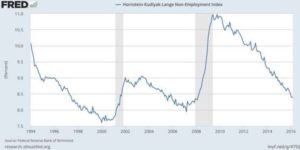Are we measuring unemployment properly?
The Federal Reserve of Richmond recently released a report on the benefits of using the NEI (Non-Employment Index), an alternative measure to the standard Unemployment Rate, to determine the health of the labor market. The Capital Region Collaborative uses unemployment rates as an indicator of the strength of our regional economy because it helps to tell if all the jobs that are available in the region are being filled.

The assumption is that if everyone who wants a job has a job, then the economy is poised to achieve its maximum output. In simple words, that means prosperity for the region.
The NEI might be a more interesting way of measuring unemployment.
- It counts not only the unemployed, but also those out of the labor force. This includes not only those who’ve stopped looking for work, but also those who do not want a job (such as retirees, students, etc.)
- It weights the different groups of non-employed differently. The NEI looks at labor market attachment (the likelihood a person will transition back into the job market). These two factors end up providing a much clearer picture of what our labor force (and potential labor force) look like.